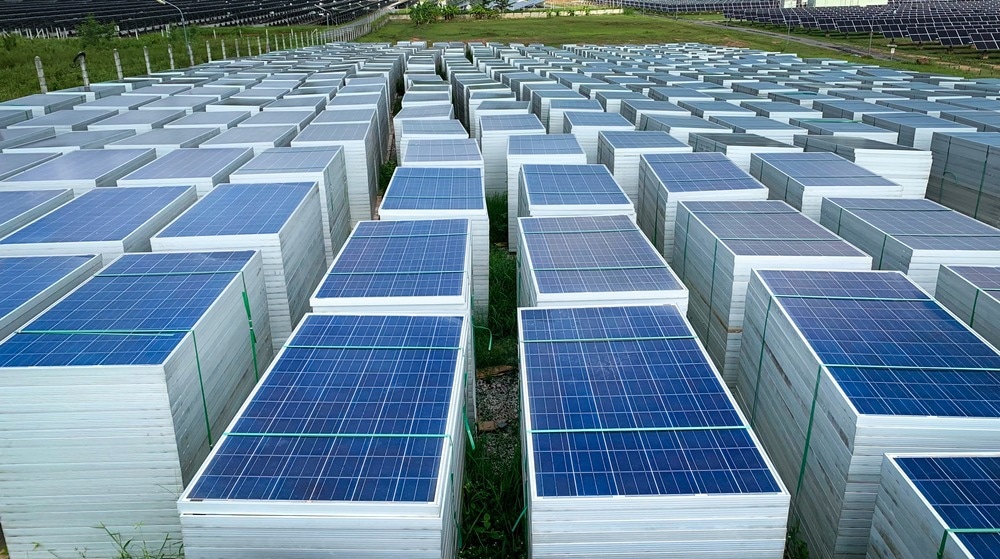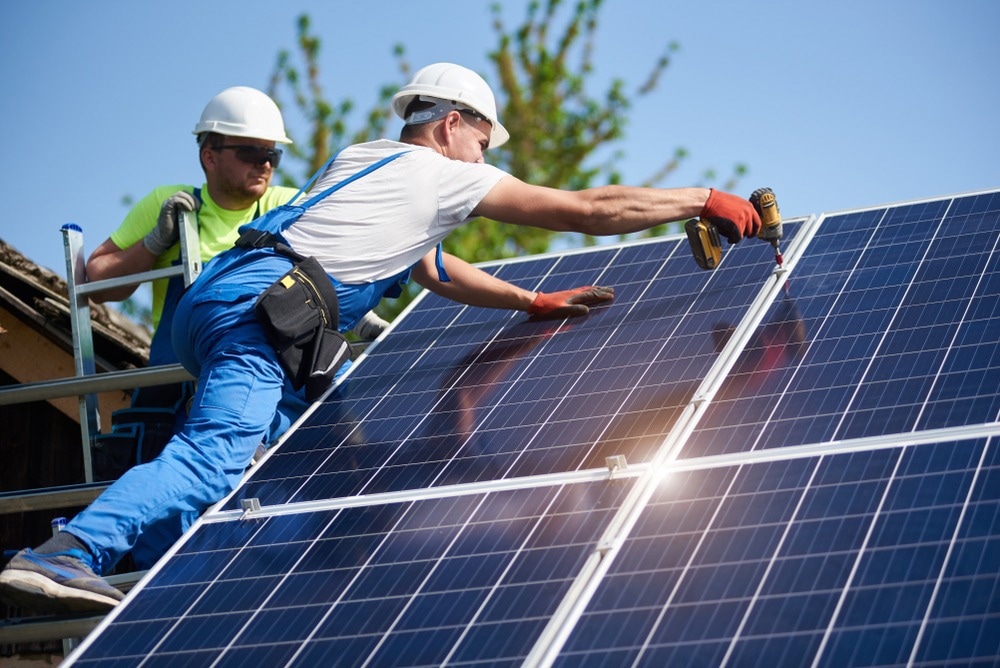The clean energy revolution is in full swing, but with it comes a new problem: waste. As photovoltaic technology gains popularity, so does the amount of waste it generates. This waste contains harmful materials that can harm the environment. However, there may be a solution in the form of plasma electrolytic oxidation (PEO) coatings.

Image Credit: Kampan/Shutterstock.com
By recycling particles from photovoltaics into PEO coatings, we can reuse waste and create a more sustainable future. In this article, we will discuss photovoltaic wastes and PEO coatings and explore the potential of PEO coatings to reduce the impact of photovoltaic waste. We will also discuss the benefits of PEO coatings and the challenges of incorporating photovoltaic waste.
What is Photovoltaic Waste?
Photovoltaic waste is made up of various materials, including glass, silicon, and rare metals such as cadmium, tellurium, and indium. These materials are used to manufacture solar panels, and they can have a significant impact on the environment if not properly disposed of. According to a report by the International Renewable Energy Agency (IRENA), the amount of solar panel waste could reach 78 million metric tons by 2050.
There are several current solutions to photovoltaic waste, including recycling and repurposing. While these solutions are a step in the right direction, there is still much work to be done to address the growing problem of photovoltaic waste. This is where the concept of recycling particles from photovoltaics into PEO coatings comes in. By repurposing the waste and incorporating it into PEO coatings, we can reduce the amount of waste generated by the industry and create a more sustainable future.
What are Plasma Electrolytic Oxidation (PEO) Coatings?
Plasma electrolytic oxidation, also known as micro-arc oxidation, is a surface treatment process used to enhance the properties of metals and alloys. PEO coatings are produced by subjecting a metal substrate to an electric current in an electrolytic solution. The process results in the formation of an oxide layer on the surface of the metal, which enhances its performance.
PEO coatings offer several advantages over other surface treatment processes. They provide improved wear resistance, corrosion protection, and thermal insulation, making them ideal for use in harsh environments. Additionally, PEO coatings are environmentally friendly, as they are produced using water-based electrolytes and do not require the use of hazardous chemicals.
PEO coatings have a wide range of applications in various industries, including aerospace, automotive, and medical. In the aerospace industry, PEO coatings are used to improve the performance of engine components and reduce wear and tear. In the automotive industry, PEO coatings are used to enhance the performance of suspension systems and reduce friction. In the medical industry, PEO coatings are used to improve the biocompatibility of medical implants and reduce the risk of rejection.
Incorporating Photovoltaic Waste into PEO Coatings
The use of photovoltaic waste in PEO coatings is a relatively new concept, and there is still much work to be done to improve the process. Future research and development efforts will likely focus on improving the consistency of the waste materials, reducing the presence of contaminants, and optimizing the PEO process for these materials.
There is also potential for the development of new applications for PEO coatings using photovoltaic waste. For example, PEO coatings with enhanced thermal insulation properties could be used in solar water heaters or other renewable energy applications.

Image Credit: anatoliy_gleb/Shutterstock.com
A study published in the MDPI Coating Journal investigated the possibility of incorporating TiO2 particles derived from the recycling process of photovoltaic panels into PEO coatings. The particles were added to the electrolyte and produced on an aluminum alloy. The samples were characterized by optical microscope analysis, SEM, XRD, and potentiodynamic tests.
It was observed that the particles lost their original shape and re-solidified in the coating due to high temperatures, resulting in changes in their crystalline structure. They were transformed into rutile after incorporation. However, the particles were successfully incorporated into the coating, and their presence did not alter the corrosion properties.
The samples with higher particle content showed increased photolytic properties, making this method a promising application for the circular economy, particularly for recycling end-of-use photovoltaic panels.
There are several challenges to incorporating photovoltaic waste into PEO coatings. One of the primary challenges is the variability of the waste materials. Photovoltaic waste can come from a variety of sources and may have different compositions, which can make it difficult to produce consistent PEO coatings. Additionally, the presence of contaminants in the waste materials can affect the quality and performance of the coatings.
Conclusion
The recycling of particles from photovoltaics into PEO coatings is a promising solution to the growing problem of photovoltaic waste. By repurposing the waste materials and incorporating them into PEO coatings, we can reduce the amount of waste generated by the industry and create a more sustainable future.
The incorporation of photovoltaic waste into PEO coatings not only provides an innovative solution for reducing waste but also enhances the properties of metal components. The resulting PEO coatings offer improved wear resistance, corrosion protection, and thermal insulation, making them ideal for use in harsh environments. Additionally, the use of PEO coatings with recycled photovoltaic waste is environmentally friendly, as it reduces the amount of waste that would otherwise end up in landfills or incinerators.
As the world continues to transition towards renewable energy sources, the use of PEO coatings with recycled photovoltaic waste has the potential to play a significant role in creating a cleaner and more sustainable future.
More from AZoM - A to Z: Building a Nuclear Reactor for Power Generation
References and Further Reading
Benedette, Cuffari (2016). Materials Used In Photovoltaics [Online]. AZoM.com. URL https://www.azom.com/article.aspx?ArticleID=12841
Gahlot, R., Mir, S., Dhawan, N. (2022). Recycling of Discarded Photovoltaic Solar Modules for Metal Recovery: A Review and Outlook for the Future. Energy Fuels 36, 14554–14572. https://doi.org/10.1021/acs.energyfuels.2c02847
IRENA (2016). End-of-life management Solar Photovoltaic Panels [Online]. International Renewable Energy Agency. URL https://www.irena.org/publications/2016/Jun/End-of-life-management-Solar-Photovoltaic-Panels
Pezzato, L., Colusso, E., Cerchier, P., Settimi, A.G., Brunelli, K. (2023). Production and Characterization of Photocatalytic PEO Coatings Containing TiO2 Powders Recovered from Wastes. Coatings 13, 411. https://doi.org/10.3390/coatings13020411
Simchen, F., Sieber, M., Kopp, A., Lampke, T. (2020). Introduction to Plasma Electrolytic Oxidation—An Overview of the Process and Applications. Coatings 10, 628. https://doi.org/10.3390/coatings10070628
Yu, H.F., Hasanuzzaman, M., Rahim, N.A., Amin, N., Nor Adzman, N. (2022). Global Challenges and Prospects of Photovoltaic Materials Disposal and Recycling: A Comprehensive Review. Sustainability 14, 8567. https://doi.org/10.3390/su14148567
Disclaimer: The views expressed here are those of the author expressed in their private capacity and do not necessarily represent the views of AZoM.com Limited T/A AZoNetwork the owner and operator of this website. This disclaimer forms part of the Terms and conditions of use of this website.